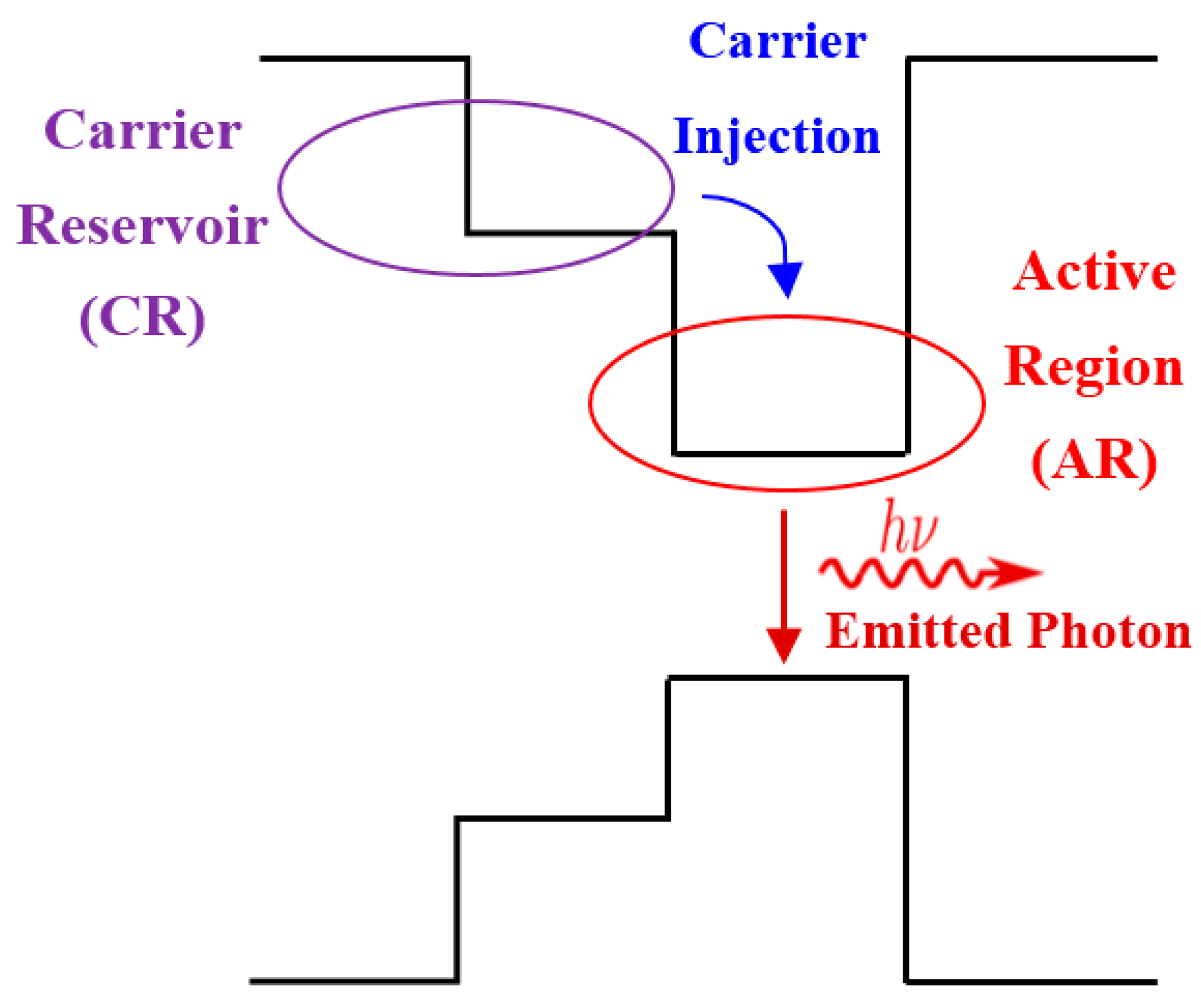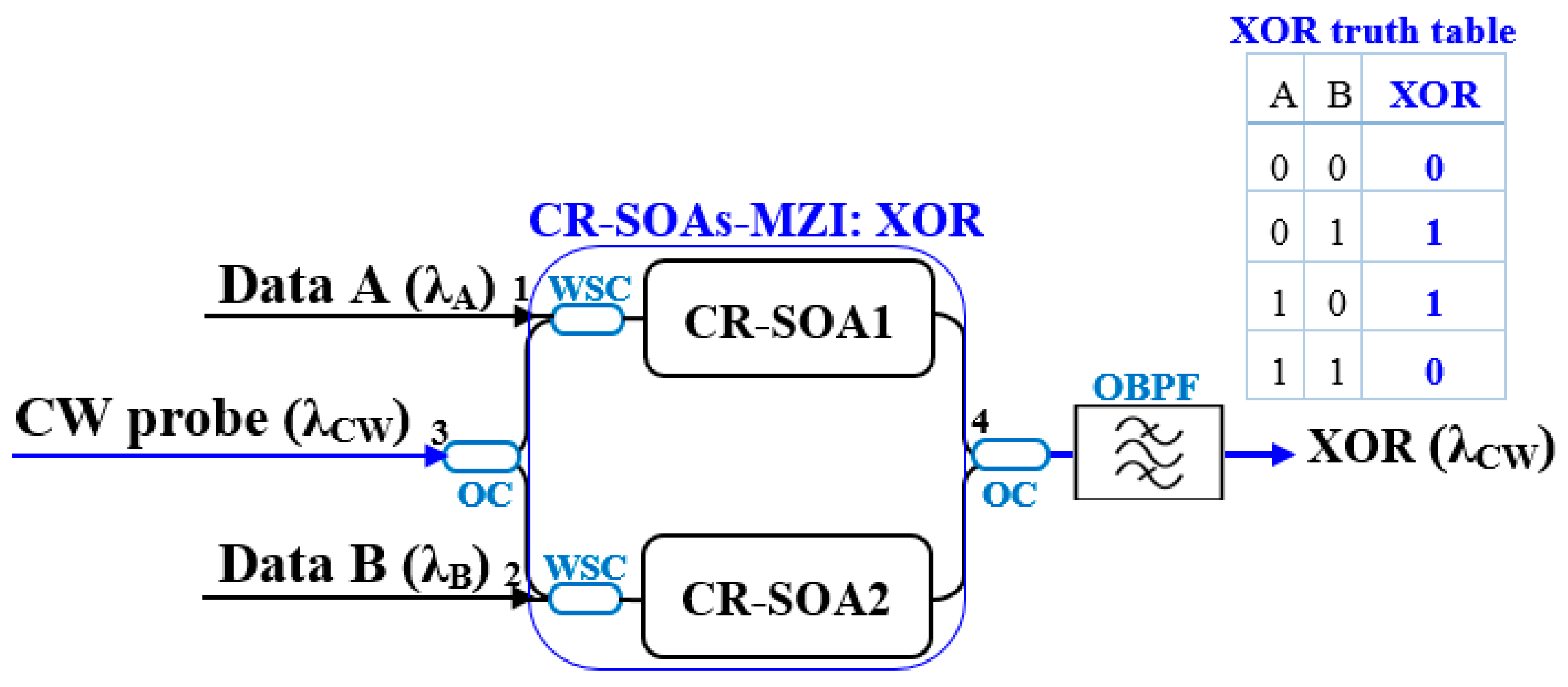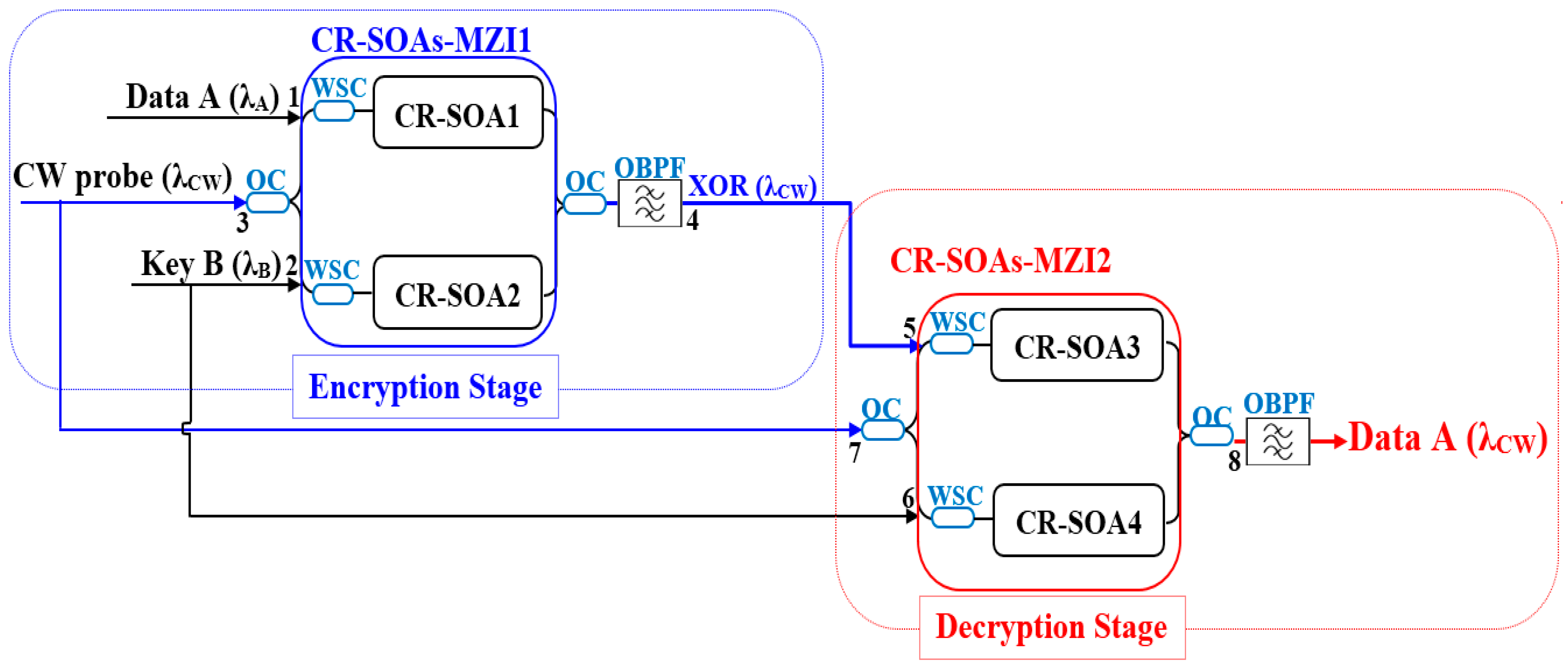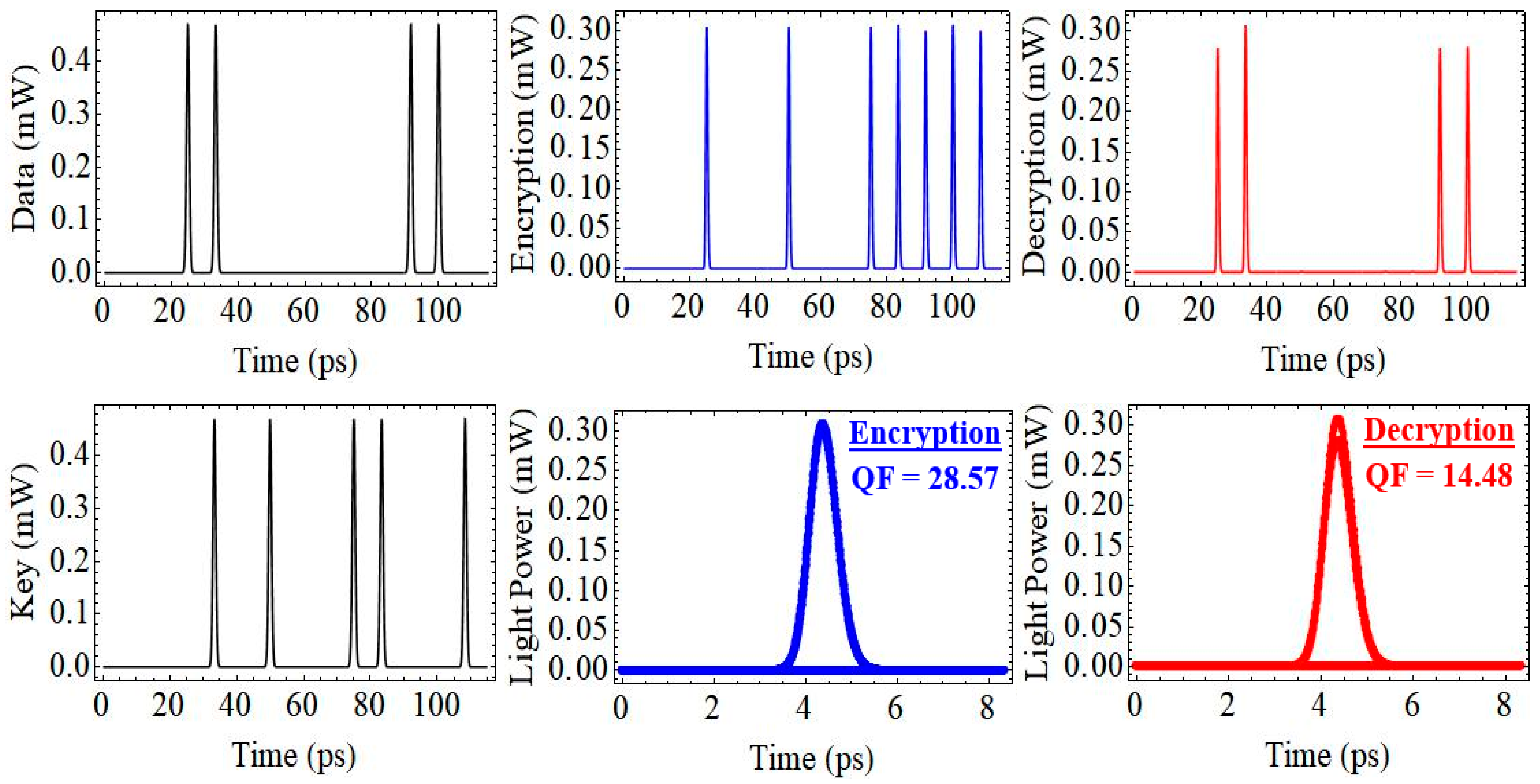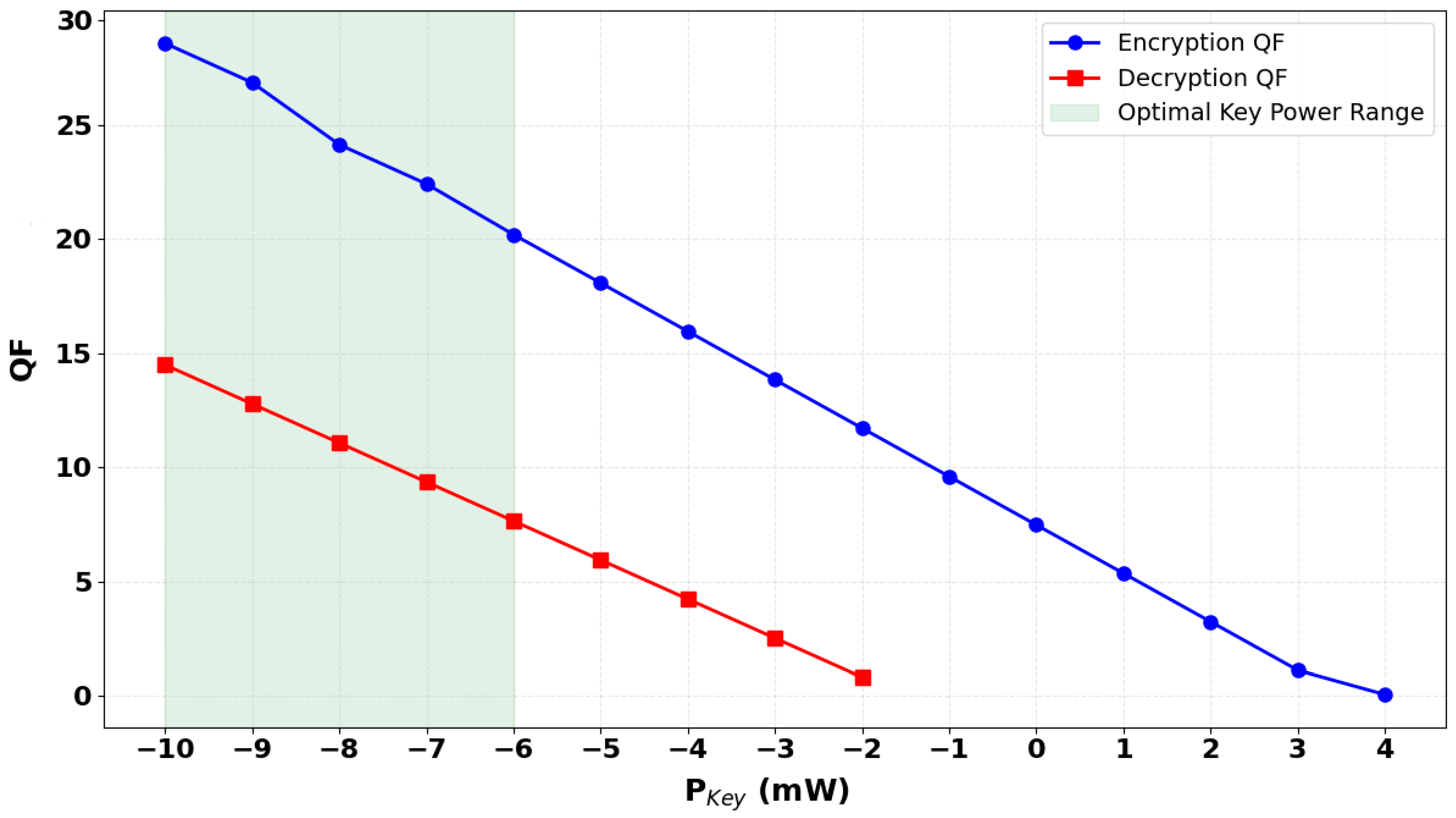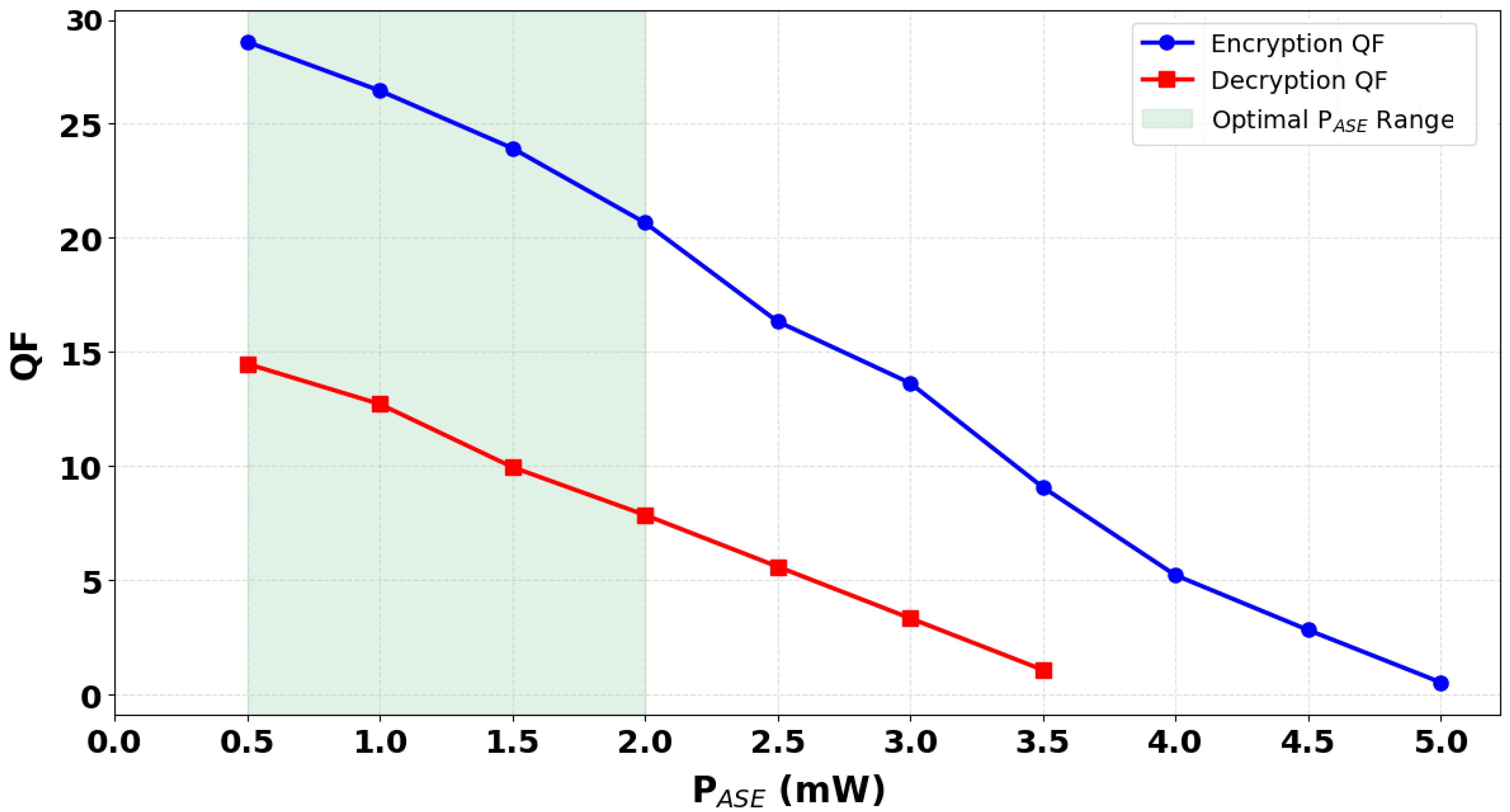1. Introduction
In the era of ever-increasing data traffic and the proliferation of high-speed communication networks, the demand for ultrafast, secure, and energy-efficient information processing systems is more critical than ever. Among the many strategies developed to meet these demands, all-optical encryption and decryption schemes have gained significant traction. Unlike traditional electronic encryption systems that require optical-electrical-optical (OEO) conversions—thereby introducing latency, energy consumption, and bottlenecks—all-optical encryption and decryption systems operate entirely in the optical domain. This enables data to be processed at the speed of light, with minimal latency and superior bandwidth handling capabilities. These systems provide data confidentiality and integrity directly in the photonic layer, which is crucial for next-generation secure communication infrastructures, especially in military, banking, quantum communication, and cloud-based platforms [
1,
2,
3,
4,
5,
6,
7,
8]. All-optical encryption typically employs binary logic operations, where the input signal (plaintext) is combined with a secure key using a logic function—most commonly the exclusive OR (XOR) logic gate—to generate a scrambled output (ciphertext). Decryption is then achieved by repeating the XOR operation with the same key, restoring the original data. This simplicity and reversibility make the XOR logic gate an ideal candidate for optical encryption and decryption applications [
1,
2,
3,
4,
5]. Beyond encryption, all-optical XOR gates play a vital role in optical computing, signal regeneration, pattern recognition, error detection/correction, and arithmetic operations [
9,
10]. Their implementation using nonlinear optical elements allows ultrafast logic processing directly in the optical domain, a key enabler for all-optical networks and photonic integrated circuits.
Among the various optical devices used to realize such functions, semiconductor optical amplifiers (SOAs) have been widely studied due to their compactness, integrability, low power consumption, and strong nonlinear characteristics such as cross-phase modulation (XPM) and cross-gain modulation (XGM). However, a major physical limitation of conventional SOAs is their relatively slow carrier recovery time, typically on the order of hundreds of picoseconds. This restricts their ability to operate effectively at very high bit rates, particularly beyond 100 Gb/s, due to inter-symbol interference, gain saturation, and pattern-dependent distortion [
11]. These issues make it challenging to maintain signal fidelity and clear logic states in high-speed optical logic circuits, thereby necessitating the development of enhanced SOA structures such as carrier reservoir semiconductor optical amplifiers (CR-SOAs). CR-SOAs introduce an additional carrier reservoir region that decouples the carrier injection from the signal interaction region. This design enables faster gain recovery times, improved saturation characteristics, and better control over carrier dynamics, making them particularly suitable for high-speed and high-fidelity all-optical logic operations [
12,
13,
14,
15,
16,
17,
18]. These characteristics also reduce pattern-dependent effects and crosstalk, both of which are critical in logic-based encryption systems operating at elevated bit rates.
To implement reliable all-optical logic gates, one of the most widely adopted configurations is the Mach–Zehnder interferometer (MZI). When integrated with nonlinear optical elements like SOAs or CR-SOAs in its arms, the MZI can perform high-speed logic functions by leveraging XPM or XGM. The phase-sensitive interference at the MZI output allows for precise control of logic outcomes, such as XOR, with high extinction ratios and low insertion losses. MZIs offer significant advantages in terms of reconfigurability, stability, and scalability, making them an essential building block in integrated photonic circuits and optical logic systems [
19,
20]. The combination of CR-SOAs and MZIs creates a powerful platform for realizing compact, high-speed, and energy-efficient logic devices suitable for data security applications.
In recent years, various theoretical and experimental demonstrations of all-optical encryption and decryption systems based on SOAs have been reported in the literature [
1,
2,
3,
4,
5,
6,
7,
8]. These studies span designs using both traditional SOAs [
1,
2,
3,
4,
5,
6] and enhanced variants like quantum-dot SOAs (QD-SOAs) [
7] and reflective SOAs (RSOAs) [
8]. While some employ complex configurations involving pseudorandom bit generators, linear feedback shift registers, and two-photon absorption (TPA) mechanisms [
6], others focus on more straightforward XOR-based schemes [
1,
2,
3,
4,
5]. These works demonstrate the viability of SOA-based technologies for secure, real-time encryption, but also highlight challenges related to signal degradation, gain recovery, and noise issues that CR-SOAs are particularly well-suited to address.
An important metric in evaluating the performance of all-optical logic gates and encryption/decryption systems is the quality factor (QF). The QF serves as an indicator of signal integrity, noise tolerance, and eye diagram clarity in high-speed optical systems. A high QF corresponds to clean, distinguishable logical ‘1’ and ‘0’ states, which are essential for accurate data recovery and secure communication. In the context of encryption and decryption, a strong QF ensures that the ciphertext and the recovered plaintext maintain acceptable levels of fidelity, even in the presence of noise sources such as amplified spontaneous emission (ASE). Therefore, tracking the QF provides crucial insight into the practical feasibility and robustness of the proposed design.
In this work, we present a high-speed all-optical encryption and decryption system operating at 120 Gb/s, implemented using CR-SOAs-based MZIs and simulated in Wolfram Mathematica 11.0. The system utilizes two consecutive CR-SOA-MZI XOR gates to perform encryption and decryption, and achieves QFs of 28.57 and 14.48, respectively, for the encrypted and decrypted signals. Additionally, we analyze the impact of key operational parameters, including ASE noise, on system performance. The proposed design offers a promising pathway toward compact, ultrafast, and scalable photonic encryption systems, particularly suited for next-generation high-speed secure communication networks.
3. Modeling
In this study, the QF is used as a key metric to evaluate the performance of the proposed optical logic functions. The QF provides insight into signal integrity by measuring the separation between logical ‘1’ and ‘0’ levels and their associated noise, which directly correlates with the bit error rate (BER) [
22]—a critical parameter in high-speed communication systems. It is defined as [
11]:
where P
1 and P
0 are the mean peak powers of logic levels ‘1’ and ‘0’, and σ
1, σ
0 represent their respective standard deviations. A QF value above 6 is typically required to maintain a BER below 10
−9, ensuring system reliability [
11,
12,
13,
14,
15]. To ensure precise results, all time-dependent equations are solved using the Adams numerical method implemented in Wolfram Mathematica
®. Renowned for its efficiency in handling complex differential equations, this method is well suited for the detailed temporal analysis of optical systems. By incorporating the QF as the key performance metric and leveraging Mathematica’s accurate numerical capabilities, this study delivers a comprehensive assessment of the optical logic gate’s operation, capturing both overall system behavior and the influence of noise and distortion on signal integrity. The simulations are conducted using the standard numerical parameters outlined in
Table 2 [
1,
2,
3,
4,
5,
6,
7,
8,
9,
10,
11,
12,
13,
14,
15,
16,
17,
18,
19,
20,
21], which include experimentally validated values from prior studies [
1,
2,
3], thereby ensuring consistency and robustness in the performance evaluation.
The dynamic behavior of the CR-SOA is governed by a set of time-dependent gain equations that accurately capture the complex interplay between carrier recombination processes and ultrafast nonlinear optical effects. Specifically, the model accounts for carrier exchange dynamics between the CR and the AR, which are fundamental to regulating the temporal evolution of the optical gain. Additionally, it includes the effects of carrier heating (CH) and spectral hole burning (SHB)—two key intraband phenomena that significantly influence both the amplitude and phase of the amplified optical signal. These ultrafast processes introduce gain suppression and nonlinear phase shifts that directly impact the performance of high-speed optical systems. As such, modeling these effects is essential for accurately simulating CR-SOA-based photonic devices, especially when operating under intense modulation and short pulse conditions. The resulting set of coupled differential equations captures the temporal dynamics of carrier densities, gain saturation, and phase modulation, forming the core framework for evaluating the CR-SOA’s suitability in all-optical logic and encryption schemes. The governing equations are provided as follows [
11,
12,
13,
14,
15]:
where
τt denotes the carrier transition lifetime from the CR to the AR, which governs the carrier transfer dynamics.
τc represents the carrier recombination lifetime, dictating how quickly carriers recombine in AR.
η is the population inversion factor, defined as the ratio of carrier densities in the AR and CR, i.e., η = NAR/NCR, indicating the efficiency of carrier injection into the gain medium.
τCH is the thermal relaxation time associated with CH, which influences the speed of thermal carrier redistribution.
τSHB denotes the relaxation time related to SHB, capturing the dynamics of carrier depletion at specific spectral components.
εCH and εSHB are the nonlinear gain suppression coefficients arising from CH and SHB effects, respectively, reflecting the extent to which each mechanism depletes the available optical gain.
The total gain of the CR-SOA is thus a combined result of the gain contributions from the active region, modified by the suppressive impacts of CH and SHB. This comprehensive gain formulation is critical for modeling the amplifier’s performance under high-speed, high-intensity optical modulation.
The unsaturated power gain, G
0, is given by:
where
Γ is the optical confinement factor, representing the fraction of the optical mode that overlaps with the gain region, thereby influencing the efficiency of light amplification.
α refers to the differential gain, a measure of how sensitively the optical gain responds to changes in carrier density.
Ntr is the transparency carrier density, the minimum carrier concentration required to achieve zero net optical gain.
I is the injection current, supplying the carriers needed for stimulated emission in the active region.
e denotes the elementary charge of an electron, a fundamental constant used in calculating carrier densities.
V = wdL represents the active layer volume, where w is the width, d is the thickness, and L is the length of the active region—this volume directly affects the carrier density and gain saturation characteristics.
The saturation energy (E
sat) is a critical parameter that defines the energy threshold beyond which the gain of the CR-SOA begins to saturate. It quantifies the maximum optical input energy the device can efficiently amplify before nonlinear effects, such as gain compression and signal distortion, degrade performance. E
sat is calculated using the following expression:
where
Psat: Saturation power
h: Planck’s constant
υ: Signal frequency
For the numerical simulations, the input optical power pulses P
in, CR-SOA(t) are modeled as return-to-zero (RZ) Gaussian-shaped pulses embedded within a pseudorandom binary sequence (PRBS) of length N. Each pulse is characterized by an energy E
0, a full width at half-maximum (FWHM) duration τ
FWHM, and a bit period T. This modeling approach accurately captures the temporal shape and data pattern of realistic high-speed optical signals used in communication systems. The PRBS pattern ensures a statistically representative sequence of logical ‘0’ and ‘1’ bits, essential for evaluating device performance under varied signal conditions. This pulse representation is mathematically described by the following equation:
In this expression, an(A,B) denotes the PRBS data streams corresponding to the input signals A and B, where each bit can assume a logical value of either ‘0’ or ‘1’.
The induced phase shift in the CR-SOA is described by:
where α represents the conventional linewidth enhancement factor (α-factor), and α
CH corresponds to the linewidth enhancement factor associated with CH. The contribution of SHB to the phase shift is considered negligible, with α
SHB ≈ 0 [
15,
18,
21].
For numerical simulation of the encryption operation, the optical input powers applied to CR-SOA1 and CR-SOA2 within CR-SOA-MZI1 are mathematically modeled as follows (see
Figure 3):
Subsequently, the output power corresponding to the encryption operation in CR-SOA-MZI1 is given by [
11]:
To carry out the decryption process, the optical input powers injected into CR-SOA3 and CR-SOA4 within CR-SOA-MZI2 are defined as follows:
Consequently, the output power representing the decryption operation, retrieved from the decryption process in CR-SOA-MZI2, is given by:
4. Results and Discussion
The performance of the proposed CR-SOA-MZI-based all-optical encryption and decryption system was evaluated through comprehensive numerical simulations using Wolfram Mathematica
® at a data rate of 120 Gb/s. The architecture consists of two cascaded XOR logic gates realized through CR-SOAs embedded in MZIs (CR-SOA-MZI1 and CR-SOA-MZI2). The system receives two input signals: a pseudorandom optical data stream (Signal A) and a secure optical key (Signal B). The encryption process is performed in CR-SOA-MZI1 using the XOR operation with key B, while decryption is achieved in CR-SOA-MZI2 using the same key, based on the logical identity (A ⊕ B) ⊕ B.
Figure 4 illustrates the temporal waveforms of the data, key, encrypted, and decrypted signals. The plots shown in the bottom middle and bottom right panels represent single-bit output waveforms (logical ‘1’) from the encryption and decryption stages, respectively. While these were previously referred to as “eye diagrams,” we clarify that they are not conventional eye diagrams involving multiple overlapping bits. Instead, they were extracted to highlight pulse sharpness, timing precision, and signal amplitude under high-speed operation. We recognize the value of including standard eye diagrams to illustrate jitter, noise, and inter-symbol interference, and we plan to present such plots in future work. The QF of the encrypted signal (bottom middle, blue) is 28.57, demonstrating a clean, high-contrast signal with minimal distortion. In comparison, the decrypted signal (bottom right, red) yields a QF of 14.48, reflecting some amplitude degradation and broader temporal features resulting from cumulative pattern-dependent effects and dynamic gain variations in the CR-SOAs. These effects are more pronounced after the second XOR stage, contributing to the observed reduction in QF. Nonetheless, both signals maintain strong temporal integrity, validating the logical accuracy and high fidelity of the encryption and decryption processes. The QF values reflect the effectiveness of the CR-SOA’s fast gain recovery and carrier dynamics in maintaining logic stability under ultrafast modulation conditions. Additionally, the system exhibits resilience to amplified spontaneous emission (ASE) noise, which can be attributed to the intrinsic noise suppression capabilities of the CR-SOA-MZI configuration. The fast carrier recovery in the CR-SOAs rapidly mitigates noise-induced gain fluctuations, while the nonlinear XOR logic operation within the MZI enhances signal contrast, effectively filtering out ASE noise contributions. Consequently, these characteristics ensure stable operation and high signal fidelity, confirming the system’s potential for secure and scalable high-speed optical communication.
To further evaluate the robustness and sensitivity of the proposed CR-SOA-MZI-based all-optical security system, the effect of input key power on the quality factors (QFs) of both the encrypted and decrypted signals is thoroughly analyzed. The key input plays a pivotal role in the encryption and decryption processes, serving not only as a logical operand in the XOR operation but also as a dynamic control signal that governs the nonlinear interference characteristics within the CR-SOA-assisted MZIs.
Figure 5 presents the variation in QF values for both encryption and decryption outputs as a function of input key power (P
Key), ranging from −10 dBm to +4 dBm. The results indicate a clear performance degradation trend in both encryption and decryption QFs as P
Key increases. At a P
Key of −10 dBm, the encryption and decryption processes demonstrate excellent signal quality, with QFs of 28.57 and 14.48, respectively. These values reflect clean, well-separated logic levels with minimal inter-symbol interference, confirming that the system operates optimally under low key power conditions. As P
Key increases from −9 dBm to −5 dBm, the QFs of both encrypted and decrypted signals decline gradually. For instance, at −6 dBm, the encryption QF drops to 20.19, and the decryption QF reduces to 7.64, indicating growing distortion in the logical transitions. This degradation was determined through simulation outputs that revealed temporal broadening, waveform distortion, and diminished contrast at higher input powers. These signal impairments correlated with known nonlinear optical effects—including enhanced cross-phase modulation (XPM) and gain saturation—captured in the dynamic model of the CR-SOA. Specifically, the simulations incorporated carrier rate equations and field propagation dynamics, which reflect the impact of increased input power on gain recovery, phase shift, and interferometric balance. At higher P
Key levels, these effects become more prominent, reducing the effectiveness of the XOR logic. Beyond −4 dBm, the performance degrades rapidly. The decryption QF falls below the acceptable threshold (QF < 3) by approximately −3 dBm, suggesting that the recovered signal becomes highly distorted and difficult to interpret. At −2 dBm, the decryption QF drops to 0.8, while encryption still retains 11.71, demonstrating that encryption remains relatively more robust but also begins to lose fidelity. Beyond 0 dBm, the decryption signal fails almost entirely, with QFs nearing zero by +4 dBm, indicating that the decrypted signal is no longer distinguishable due to excessive nonlinear interference and phase mismatch in the CR-SOA-MZI2 structure. This behavior highlights a critical trade-off: while a certain level of optical power is necessary for maintaining gain and facilitating nonlinear interaction in CR-SOAs, excessive key power introduces detrimental effects, such as carrier depletion, XGM, and XPM, that hinder the proper operation of the XOR gates. The encrypted output remains functional longer due to its position earlier in the cascade (CR-SOA-MZI1), whereas the decryption gate (CR-SOA-MZI2) is more vulnerable to upstream distortions and cumulative ASE noise. In addition to performance sensitivity, the overall power efficiency of the proposed architecture has been estimated based on simulation parameters. The system operates optimally when the key input power lies within the range of −10 dBm to −6 dBm, where both encrypted and decrypted signals retain high QF values. Under these conditions, and accounting for component losses and CR-SOA gain, the net optical power efficiency is estimated to be 15–20%. This range represents a trade-off between ensuring sufficient nonlinear interaction and avoiding excessive phase distortion or gain saturation. The results suggest that proper key power tuning not only ensures secure encryption but also supports energy-efficient operation of the system. These results underscore the importance of carefully tuning P
Key to maintain system integrity. The optimal key power window lies around −10 dBm to −6 dBm, within which both encrypted and decrypted outputs retain acceptable QFs for reliable transmission and recovery. Outside this range, especially for positive key powers, the system becomes increasingly susceptible to degradation. Furthermore, the simulations affirm that CR-SOAs offer strong potential for high-speed secure operations, provided that nonlinearities are properly managed. The performance sensitivity to key power also reinforces the value of power-aware encryption architectures, where the intensity of the key serves as a secondary security parameter—any deviation from the optimal power range can render the decryption process ineffective, thereby enhancing the system’s resilience against unauthorized access.
In this study, we numerically incorporated amplified spontaneous emission (ASE) noise into the output power equations for both encryption and decryption, specifically Equations (13) and (16), to realistically assess the performance of our 120 Gb/s all-optical system based on CR-SOAs-MZIs. ASE is a fundamental noise mechanism originating from spontaneous carrier recombination events in the SOA’s gain medium, which emits incoherent photons that accumulate along with the amplified signal. Unlike stimulated emission, ASE contributes broadband noise that degrades the signal’s coherence and reduces the signal-to-noise ratio, particularly detrimental in high-speed photonic logic systems. To capture this degradation, ASE power [
18] was systematically varied and added numerically to the output power calculations. As shown in
Figure 6, the QFs for both encryption and decryption decrease sharply with increasing ASE power. Specifically, when the ASE power increases from 0.5 mW to 5 mW, the encryption QF drops from 28.57 to 0.54, while the decryption QF declines from 14.48 to nearly zero. This inverse relationship illustrates the detrimental impact of ASE on system performance. Interestingly, at each level of ASE power, the QF for encryption is consistently higher than that for decryption. This behavior suggests a differing sensitivity of the two operations to ASE noise, likely arising from asymmetries in gain saturation, nonlinear phase shift accumulation, or interference contrast between the arms of the MZI during signal recombination. By numerically including ASE in the model, we achieve a more realistic representation of system behavior under noisy conditions, moving beyond idealized assumptions. This approach enables accurate prediction of performance limits and helps define acceptable operating windows for SOA biasing and input power levels. The results emphasize that even moderate increases in ASE can significantly impair logic operation, especially at ultrafast speeds such as 120 Gb/s, where signal degradation leads directly to reduced encryption fidelity and unreliable decryption. Therefore, mitigating ASE through optimized SOA design, use of narrowband optical filters, and controlled operating parameters is critical to maintaining high quality factors and ensuring the robustness and security of the all-optical logic gate system.
5. Comparative Performance Evaluation
The proposed all-optical encryption and decryption system employing CR-SOAs-MZIs operating at 120 Gb/s marks a significant leap forward compared to prior SOA-based architectures in both data rate and signal integrity, as evidenced by the results in
Table 3. Initial experimental demonstrations, such as those by Son et al. [
1] and Jung et al. [
2], utilized conventional SOAs and were limited to data rates of 10 Gb/s and 2.5 Gb/s, respectively, achieving modest quality factors (QF ≈ 5.4) and extinction ratios (ER ≈ 7.0 dB). These limitations were largely attributed to the slow carrier recovery time of traditional SOAs, which introduces pattern-dependent distortions and restricts scalability to higher bit rates. To address this, Yang et al. [
3] proposed an SOA-based encryption/decryption scheme leveraging four-wave mixing (FWM) for non-return-to-zero differential phase-shift keying (NRZ-DPSK) signals at 10 Gb/s, achieving ERs of 9.0 dB and 9.3 dB. Despite the added benefit of wavelength conversion, FWM-based systems are highly sensitive to phase mismatch and suffer from design complexity. Simulation-based designs have pushed the performance boundaries further. Agarwal and Chaurasia [
4] presented a 40 Gb/s system using copropagating pulses and CW inputs in SOA-MZI configurations, reporting a QF of 13.50. More recently, Singhal et al. [
5] developed a 250 Gb/s encryption/decryption circuit using SOAs and demonstrated strong simulated performance with QF = 19.65 dB and ER = 21.2 dB. Zhang et al. [
6] introduced a two-photon absorption (TPA) mechanism in SOAs at 250 Gb/s, though the QF was limited to 7.20 due to nonlinear impairments and sensitivity to input power. In a separate work, Li et al. [
7] utilized quantum dot SOAs (QD-SOAs) for high-speed encryption, achieving a QF of 8.20, but practical deployment remains constrained by fabrication and integration challenges associated with QD structures. A notable improvement came from Bosu and Bhattacharjee [
8], who proposed encryption and decryption circuits using reflective SOAs (RSOAs) at 100 Gb/s. Their simulated results revealed excellent performance with QFs of 25.28 dB and 18.27 dB, and contrast ratios (CRs) of 41.12 dB and 29.52 dB. However, RSOAs require tight control over optical feedback and cavity design, complicating integration into scalable systems. In comparison, the CR-SOA-based encryption and decryption system presented in this work operates at 120 Gb/s and achieves superior simulated QFs of 28.57 and 14.48 under varying input key powers. This high-speed performance is primarily attributed to the unique carrier reservoir structure, which enables faster carrier recovery, minimizes gain saturation, and ensures robust logic operation under realistic conditions. Unlike previously reported systems that rely heavily on idealized simulations or complex nonlinear effects, the proposed CR-SOA-MZI architecture strikes an optimal balance between speed, integration simplicity, and performance. These findings establish this work as a new benchmark for future secure, ultrafast, and energy-efficient all-optical data processing systems suitable for deployment in high-capacity photonic communication infrastructures.
7. Conclusions
This work presents a high-speed all-optical encryption and decryption system operating at 120 Gb/s, utilizing CR-SOAs embedded in MZIs. By cascading two XOR logic gates, the system performs both encryption and decryption using a shared optical key, ensuring secure and ultrafast data processing through phase-sensitive interference. Numerical simulations using Wolfram Mathematica® confirm excellent signal integrity, with QFs of 28.57 and 14.48 for the encrypted and decrypted signals, respectively. The system demonstrates high resilience under low-key power and moderate ASE noise, with performance degrading only beyond specific thresholds. This analysis reveals the critical importance of input key power optimization, as excessive nonlinearities can compromise logic fidelity, particularly in the decryption stage. Compared to previous SOA- and QD-SOA-based systems, the CR-SOA-MZI architecture achieves superior performance in terms of speed, integration simplicity, and robustness. The fast carrier recovery and reduced pattern dependence of CR-SOAs enable scalable, low-latency, and noise-tolerant operation, positioning this approach as a strong candidate for next-generation secure photonic networks. In summary, this study establishes a solid foundation for the development of energy-efficient, ultrafast all-optical security systems. Future efforts will focus on experimental validation and system-level integration to extend the applicability of this architecture to real-world optical communication infrastructures.
